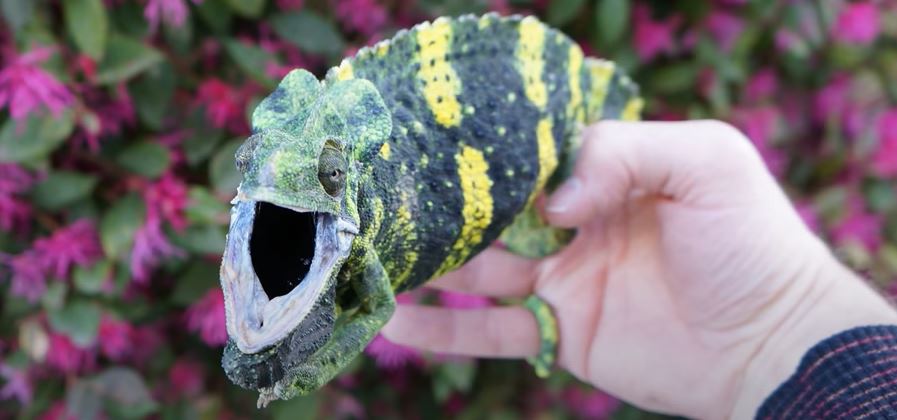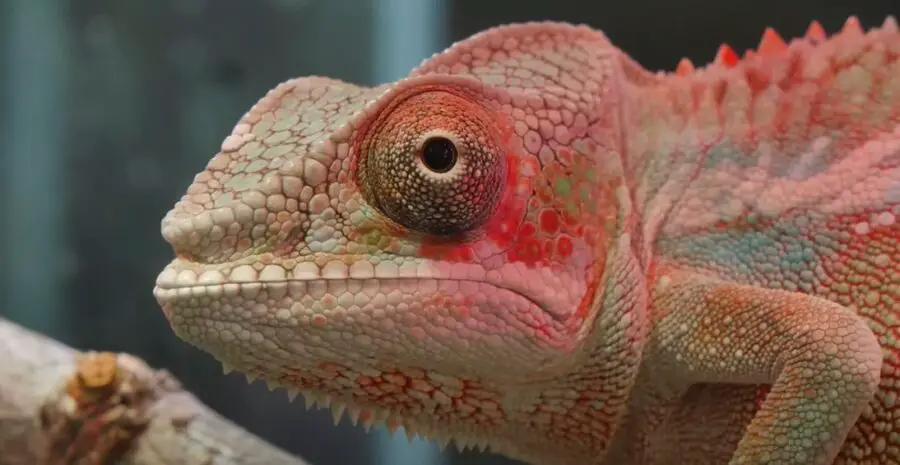My chameleon bit me. It was my fault. Find out what I did wrong in this article.
What are some warning signals for us to back off? What can we do to prevent chameleons from feeling threatened?
Let’s jump into an informative article to help you discover why, how and do chameleons bite humans?
Do Chameleons Bite Humans?
Bites happen, but they shouldn’t hurt too much. Your chameleon might be warning you to back off right now because they feel threatened, haven’t adjusted to this new habitat and a few more reasons that we would love to share with you.
You should be able to avoid a tetanus shot or a visit to a doctor’s office. Rough handling, sudden movement or feeding foods like mealworms too quickly may trigger a chameleon to bite. What can you do about it? Let’s find out.

Are Chameleons Dangerous?
Chameleons will not:
- Produce venom
- Expel toxins from their skin
- Transmit diseases
These reptiles need their personal space and ability to maneuver in areas that should be peaceful around them. High traffic areas, loud noises or vibrations and sudden movements may cause a chameleon to lash out.
An inexperienced handler may stick out a finger in their face and receive a bite in response. If you hear a hiss or their mouth is open, they are gaping and warning you to stand down.
Overall, I find that chameleons are low risk, high reward reptile companions and a great pet to care for. The last time I was feeding my chameleon hornworms, I almost got bit, but that was my fault because I was rushing and moved too quickly.
Why Did My Chameleon Bite Me?
Are you new to the reptile pet world or was this a freak occurrence? Some people may care for their reptile compassion such as a chameleon for months or longer than a year without any trouble and suddenly, the hiss and immediate snap follows.
Your finger or arm becomes may become the minor, but collateral damage of a mild chameleon attack. What happened? Your aggressive chameleon needs time to get to know you and your movements.
The slower and smoother you react, glide and gently work around their territory within the enclosure or around it, the more calm and relaxed your chameleon will be.
- A perceived threat, sense of danger, fear and frightened chameleons will feel stress.
- A sick, impacted, hungry or vulnerable chameleon who is experiencing pain, trauma or injury may feel the need to stay on guard in their susceptible state.
- A satisfied, comfortable, well adjusted and trusting chameleon will not wish to bite you as long as you are in your usual calm and relaxed state as well.
Be smooth, gentle and continue the routines that your chameleon depends on to keep the peace, calm, and clean environment that chameleons appreciate.

Can I Hold My Chameleon?
Overall, we would have to say that chameleons are not a pet that likes to be held. They have never adapted to life where they cuddle with their own counterparts or caregivers. Some chameleons may gently float their eyes closed or relax them when you make contact.
Their neck may soften and your chameleon may climb aboard your arm or shoulder. Allow them to initiate the action and be open to it.
Rough handling, quick movements and sudden apprehension, tension, stress or reluctance from inexperienced may cause people to receive backlash from a scared chameleon who may bite or retreat.
It took a couple of months for my chameleon to use my shoulder as a perch. During this time, I take deep breaths as he teaches me that it is best to be calm in my actions with or without my reptile pet teaching me to do so. Thanks to my chameleon Kam for making help me become more mindful!
Do Chameleons Have Teeth?
The size of a chameleon’s teeth and the positioning of them makes it hard for us to notice their presence. The teeth are there and they are pointy. They use them to crush insects or mealworms, but they might have to try and bite your finger if you get too close, make them feel threatened or invade their space.
- There is no gap between the tooth socket and the tooth contained within it.
- These teeth won’t fall out or get replaced.
- Chameleons have no teeth on their palate.
- Each maxilla of a chameleon and dentary areas hold 15-22 teeth.
- The premaxilla holds 2 or less smaller sized teeth compared to the rest.
This is all they need to take care of their insectivore lifestyles in the wild. Thankfully, shallow teeth are not a major threat to piercing our skin or sending us rushing to the emergency room.

How Do Chameleons Defend Themselves?
Chameleons are not aggressive compared to many other predators in the wild, They hunt insects with camouflage and stealth patience.
They would rather an insect approach them unsuspectingly as the blend in with a branch for example. One snap of the tongue and dinner is served. As far as defense mechanisms are concerned, chameleons exhibit the following:
- Armored scales that are hard to pierce through
- Blending in with camouflage
- Jerky movement or funny walk to imitate the way leaves move
- Puff themselves up
- Gape their mouth or jaw open
- Hissing sounds
- Occasionally bite
- Ability to dart with relative speed and quickness
A chameleon might be revealed and needs to stand their ground or flee the scene. They can do both. This is a survivor reptile who has graced their presence on this planet longer than us as humans.
The puffing up is not as pronounced as many marine animals for example, but it is enough for this diminutive creature to look bigger.
The hissing sounds are intimidating when a chameleon gapes with their jaw open. It is a signal for us that it is time to back off. They defend themselves when they need to, but their greatest skill in the wild is when they go about their business unnoticed.
Why Chameleons Hiss
Have you ever heard your chameleon hissing? They could do this when they feel an unknown vibration and see new shapes fill their field of vision.
Larger objects or quick moving items near them including the fingers of inexperienced handlers may warn a chameleon that they have been spotted and their personal space is threatened.
The first reaction might be to freeze and hiss. This is usually coupled with gaping when they open their jaws wide. The hissing is a pronounced sound and much louder when a smaller or relative sized animal approaches them.
The hiss may sound similar to a snake, but there is no threat of venom behind it. The hissing sound only releases air and prepares their mouth in an open position to be ready to bite if necessary.

What To Do If A Chameleon Bites You?
Since you will not receive the transmission of venom, toxins or poison, you can take a deep breath after a chameleon bite and feel some of the pain or stinging resulting from it.
The teeth are so shallow that they rarely, if ever, pierce through the skin. If there is any bleeding, it will not be deep enough to affect any arteries or cause serious damage.
- The wound could be washed with saline solution, salter or pure water.
- You can add iodine hydrogen peroxide or ethanol alcohol for an added antiseptic stinging feeling.
- Dress the wound if you wish with a bandage or let it dry without touching anything.
- Finally, you can apply antibiotic ointment like Polysporin, Neosporin, Gentamycin and many other topical ointments meant to speed healing and ward off any secondary germs that could infect the bite.
The next thing you can do is learn from the bite and figure out why it happened. Why was your chameleon intimidated, scared or feel forced to bite? Could we adjust our movements, the items in the enclosure or learn some cues to back away?
When To Leave A Chameleon Alone?
Chameleons need time to adjust to their surroundings when they first arrive to your home. They would also like a little privacy from time to time even when they trust you and are comfortable in their enclosure.
If you add any live insects in their enclosure and ignite their senses to feed, it’s time to back off. If there are too many loud sounds a chameleon may not wish to be held or handled.
Final Thoughts
Anyone moving too quickly is a threat. If a chameleon is puffed up, upright or hissing, avoid contact. If a chameleon is gaping with their jaws open wide, keep clear or leave them alone for now. Chameleons are solitary reptiles who have not learned to accept petting, grooming or cuddling.
We cannot project our own feelings or that of other pocket pet companions like guinea pigs onto a chameleon from a completely different background and history of adapting to their habitat and surrounding environment.
Thank you for visiting PocketPetCentral.com for the best information to help you enjoy the life of your pocket pet companion in a fun, safe & healthy way.

